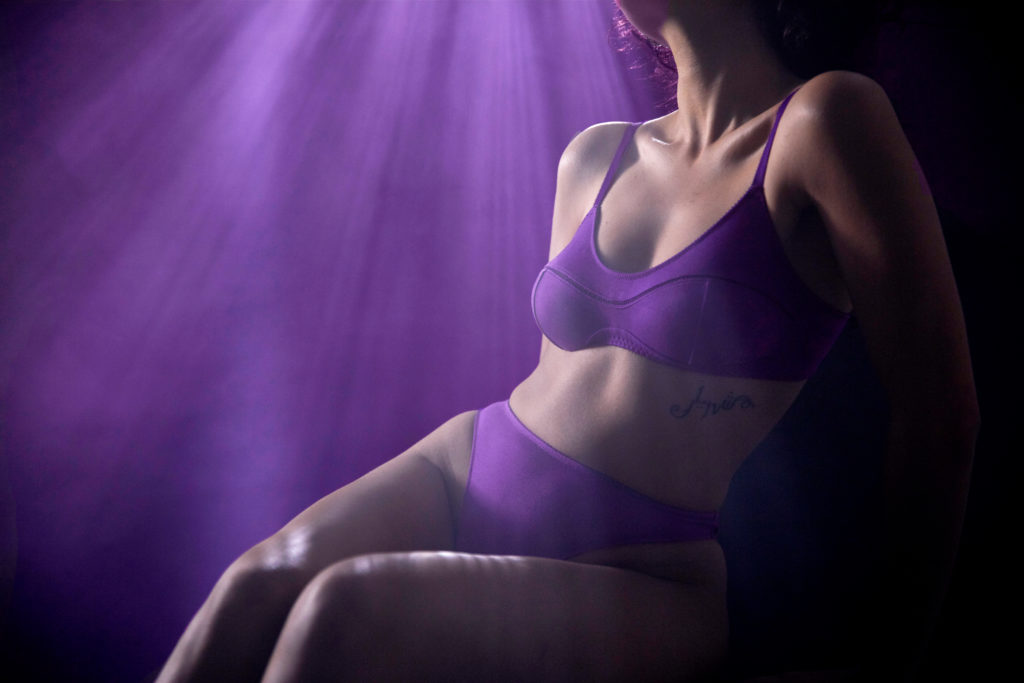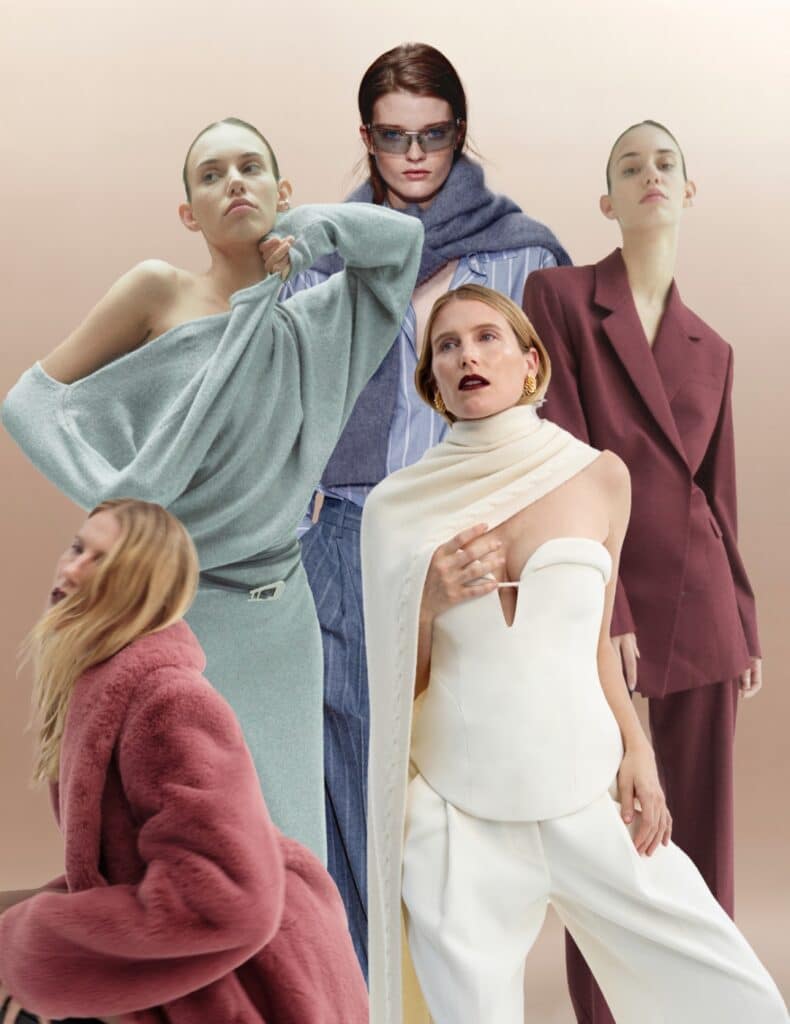
Chloé Julian — the designer formerly of Stella McCartney; Agent Provocateur; and, most recently, vice president of design for Savage x Fenty — is a woman of ritual, intention, and balance. Upon first meeting, I spot her in a bustling, inner-city cafe almost instantly, not realising until much later that perhaps it was her aura — an air of grounded sophistication and creative energy — that led me to identify her so quickly. She solidifies my thoughts by pointing to the strap of the olive bra she’s chosen to wear today — a colour that symbolises and celebrates sacred feminine energy and power.
It seems rather fitting that Julian’s most recent endeavour — her independent lingerie line — is called ‘Videris’, a Latin term that translates to, ‘you are seen’. Enlightened lingerie is how she describes her product, and it’s precisely that. Videris is crafted consciously, both for the people and the planet. The brand’s 30-piece collection is made from 100 per cent Oeko-Tex Standard 100–certified Tencel — botanic fibres created from renewable wood sourced from sustainably managed plantations in a closed-loop production process. Materials aside, Videris also aims to redefine the social norms and feelings associated with the bra — a garment Julian points out has not changed dramatically since its invention in 1893.
Julian recalls reading a recent piece from Vogue that suggests the metamorphosis of the bra is a reflection of the transformation of the modern woman. She begs to differ. “I disagree. Women have evolved, but the essence of the bra has not. It is still restrictive, it is still uncomfortable, and there is still an expectation from society that women wear one. Whilst I don’t think there is still the subjection of the mind that the corset of the 1870s was thought to bring about, I do think there is control placed over our bodies by the [under] wire.” She goes on with a smirk to speak of that all-too- familiar mid-afternoon feeling, where the body starts to tire of the bra’s underwire pressure, and then, the diaphragmatic relief that comes with removing it.
While there have been minor shifts in the bra’s design over the past 127 years — innovations in textile technology, stretch fabrics, foam (and water) padding, shapes, and trims — the essence of the 1893 underwire bra is still prevalent, and favoured, but perhaps only by default. “It’s always been that [way], but why? Can we do that better?” Julian is quick to admit that despite her 15 years of lingerie-design experience, the ‘why’ was something she never questioned. Julian goes on to speak of her relationship with this one garment that has defined her career for over a decade, and the moment that made her reflect on the ‘why’. “I had just gone through pregnancy and breastfeeding where my breasts were probably at their largest and most changeable and I didn’t wear a wire for support. But now [going back to work] I needed to go back to a wire for support — when I had become smaller again! The whole reason why I was wearing a wire didn’t make sense any more.”
Julian’s return to the workforce saw her commuting between Los Angeles (LA) and Auckland every month for two years. The years of juggling time zones; frequent travel to LA, London, and China; fashion calendar deadlines; and motherhood eventually took their toll. “What I was presenting to everyone was all under control and amazing, but on the inside it was a different story. I didn’t even have the time to address how I really felt within. I realised that true wellness came when I managed to balance my inner and outer self.” The aforementioned questioning of why, and a life that needed realigning, sparked the birth of Videris.
“It’s easy for busyness to become part of your identity,” says Julian, her words hitting far too close to home. She goes on to discuss the skewed mentality of wearing busyness as a badge of honour and the importance of letting this identity go. “The starting point [for Videris] was to create an intention to focus on our inner self, that which can’t be seen — feelings, intuition, emotions, thoughts, spirituality, values, purpose, and beliefs — over the daily demands of the often more dominant outer self, that which can be seen, and is what we present to the outside world.” In prioritising the inner self over the outer self, Videris shifts the traditional lingerie paradigm from portraying how one is ‘seen’ — by others and oneself — to asking “How do I feel?” and, “How do I want to feel?”
Videris’ key symbol of intention is colour. I look at Julian’s collection of notes and she’s quick to point out, “I always write in turquoise, because it’s about open communication and clarity of thought.” Julian’s studies into colour theory began when she was working between LA and New Zealand. A friend advised she wear the colour purple, specifically for meetings, and to tap into her gut instincts and intuition among strong personalities. From that moment, colour became a daily ritual for Julian, with the properties of each colour determining the exact seven shades she would launch Videris with.

Each bra and knicker is available in seven different colours — each with seven different meanings. There’s Olive, for new beginnings, feminine leadership, and power; Rosy Pink, for nurturing, innocence, and unconditional love; Future Violet, for imagination, spirituality, and individuality; Poise Green, for balance, hope, and growth; Bohemian Magenta, for harmony, emotional balance, and free spirit; tones of Pure White, for wholeness; and Shield Black, for power. It can’t have been an easy task to pare an infinite spectrum down to just seven shades, but Julian did more than her fair share of research. She opens her Moleskine notebook to show me. It’s filled with colour analysis, colour-related idioms of the past and present, phrases, quotes, and colour vision theories from the likes of Johann Wolfgang von Goethe and Jonathan Swift.
Colour psychology — the effect of colour on our perception, moods, and behaviour — isn’t largely spoken of in the fashion realm, unlike our neighbouring beauty industry or in the advertising and marketing world, where it’s an essential tool for creativity. But instead, colour and dress are somewhat of a spontaneous act that Julian wants to place more importance on — the daily ritual of getting dressed. “The idea around it is tapping into the traits of each colour and using it as a moment for ourselves … It’s about taking the moment to acknowledge it and set an intention for the day,” she says.
Julian realises the challenges in encouraging a slower, more mindful approach to dressing, as well as redefining women’s relationships with their bra (wire or no wire). Still, she acknowledges it with grace, determination, and compassion. Today, Julian wears Olive — she reads out the colour’s properties from her swing tag. “Through acceptance and empowerment you enable others to flourish and radiate alongside you.” And it seems, only months shy of launching Videris, she’s well on her way to achieving just that.











